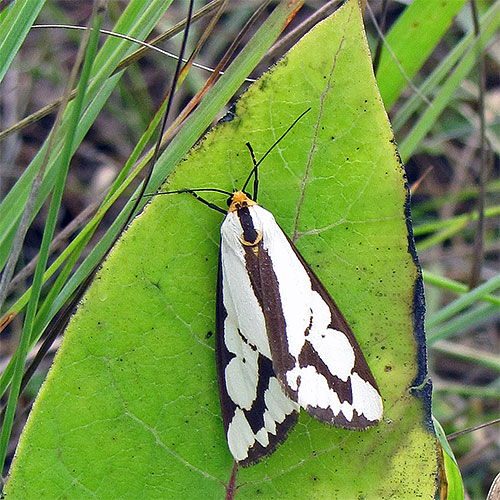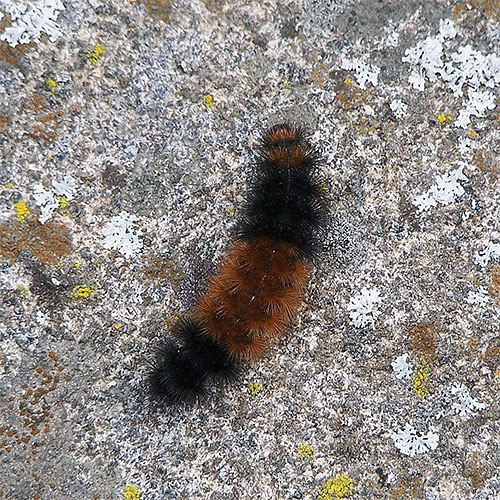Greetings, BugFans,
Tiger Moths
Tiger moths are in the family Arctiidae, a diverse group with worldwide distribution and 250 species in North America. Arctiid moths are unusual in that they have an organ on their thorax that vibrates to produce ultrasonic sound. They “vocalize” to attract mates and to defend against predators. If you have sound-making ability, you also need “ears,” and those are on the thorax, too. Adults of many species are hairy and sport striking colors, stripes or patterns, explaining the “Tiger” part of the name. The moth pictured is an Arctiid, probably Leconte’s Haploa (Haploa lecontei), unless it’s a Colona Moth (H. colona). One hundred years ago, in his definitive reference The Moth Book (still available to cagey web surfers), W.J. Holland wrote that “The genus Haploa… has furnished a great deal of amusement to classificationists.”
Woolly Bears
Many of their caterpillars are fuzzy, earning a group name of woolly bears or woolly worms. The woolly bear du jour is the ultra-familiar rust-and-black-banded caterpillar of the unspectacular Isabella Tiger Moth (ITM) (Pyrrharctia isabella). There is an amazing amount of information out there about woolly bear caterpillars (WBCs), and much of it is contradictory.
ITMs lay their eggs on a wide variety of plants during the warm months. While some caterpillars are known for their picky eating, WBCs are generalists. They feed during the day, munching on handy, low-growing plants like grasses, “weeds” and wildflowers. WBCs, surprisingly, spend the winter as caterpillars, out of the weather under tree bark and debris. Do they become “bug-cicles”? Yes, indeed. But, like other organisms that are dormant in the deep freeze of winter, WBCs produce a chemical called a cryoprotectant (antifreeze) that safeguards living tissue against damage from freezing and thawing. WBCs will stir and walk around the landscape on mild winter days and go back into hiding when the temperatures drop again. In spring, they wake up and resume eating. When they are ready to pupate, they create a fuzzy cocoon into which they incorporate their own “hairs” (setae).
Speaking of setae. An area of disagreement among references is whether the WBCs’ setae/hairs/bristles are irritants. Having a bristly covering discourages some predators, although in the Fieldbook of Natural History, E. L. Palmer says that “skunks and a few other animals roll hairs off the caterpillars before they eat them.” Certainly, the stiff hairs make it a harder to pick WBCs up, and when you do pick one up, and it inevitably curls into a defensive ball, it’s pretty slippery. Some sources say that the WBC’s setae contain a stinging/irritating/venomous chemical, and other sources specifically say they do not. Still other references say the setae may cause dermatitis mechanically—that they might break off in your skin (like one of those wretched, furry cacti); and others say that that unlike many hairy caterpillars, WBCs are harmless. The problem is, of course, that there are many different kinds of caterpillars that are called WBCs. The BugLady has never suffered any ill effects from handling WBCs.
Woolly bears have been famous since Colonial times for two things: 1) their habit of crossing the roads in fall; and 2) their alleged ability to predict the weather. Since their eating habits are catholic and they are literally surrounded by edibles, their autumnal wanderings are chalked up to searches for wintering sites. The BugLady wonders what they crossed before the Colonists arrived and started making roads.
The weather lore angle was initiated by those same, road-building Colonists, who needed some forecasting done in those pre-Weather Channel days so they could figure out when to plant and harvest crops. If its rust-colored middle band is wide, says the Almanac, the winter will be a mild one; if there is lots of black, batten down the hatches (except for a few sources that say the opposite—that lots of rust means lots of cold).
A surprising number of scientists have felt obligated to leap in and deflate the weather connection. To them the BugLady says “lighten up, Party Poopers.” They tell us that the widening middle band is a result of age; each time WBCs molt, a black band becomes a rust band (except for a few who say the opposite—that rust turns to black). So, a rustier WBC is an older WBC. The BugLady has been curious about why the early fall WBCs seemed more pessimistic than the later fall WBCs and is happy to have that one solved. In spring, a blacker WBC is one that became dormant prematurely, and so it actually is telling the weather—of the previous fall. Other research suggests that a WBC with lots of rust lived in dry conditions, and one that has wide black bands grew up where the habitat was wetter. Still other scientists say that there is considerable variation in color within newly-hatched individuals from a single clutch of eggs, and that variation persists.
We have Dr. Curran, a curator of insects at the American Museum of Natural History, to thank for popularizing the WBC. For eight years in the late 1940’s and early 1950’s, Dr. Curran drove north from NYC along the Hudson to Bear Mountain State Park to measure the coloration of the WBCs he found there. During those years, the rusty bands totaled about one-third of the caterpillars’ bodies, predicting mild winters. He “leaked” the forecasts via a friend at a NYC newspaper, and the publicity his reports generated put the WBC on the map. But Dr. Curran’s only real hypothesis was that “Scientists Just Want to Have Fun.” He and his friends enjoyed the scenery, the foliage and the WBCs on their annual fall forays and formed “The Original Society of the Friends of the Woolly Bear.” Thirty years after Dr. Curran’s outings ceased, the Bear Mountain State Park folks resurrected the Friends organization and the woolly bear count.
WBCs are embraced by children and adults alike. Annual Woolly Bear Festivals are observed in Beattyville, KY; in Vermillion, OH (begun in 1973, it features a costume contest for children and pets); in Banner Elk, NC (started in 1977, it highlights a race with more than 1,400 racing caterpillars; the winner gets to make the forecast);; and in Camago, IL (since 1987, the festival has included food booths, music, and a vertical race, with WBCs climbing up strings).
In answer to last week’s request for WBC reports: Mike, Molly, Bill, Carrie, and Lesley have seen “one-to-several” woolly bears, and Mark, Jean and the BugLady have not seen any of these normally common caterpillars. The place should be crawling with them. The BugLady has been astounded by the decrease in butterfly numbers and species this summer (which has been attributed to the cold and/or wet springs of 2008 and 2009. And when the first butterflies emerged this summer, there were few flowers for them to nectar on). She wonders if moths are having a similar population decline.
The BugLady

